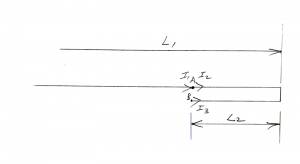A pair of conductors in proximity of some other conductors or conducting surface (such as the natural ground) can operate in two modes simultaneously, differential mode and common mode.
Differential mode is where energy is transferred due to fields between the two conductors forming the pair, and common mode is where energy is transferred due to fields between the two conductors forming the pair together and another conductor or conducting surface.
The currents flowing in the two conductors at any point can be decomposed into the differential and common mode currents.
Differential current Id is the component that is equal but opposite in direction, it is half the difference in the two complex line currents I1 and I2.
Common mode current Ic is the component of the line currents common to both conductors, it is half the sum of I1 and I2.
- Id=(I1-I2)/2
- Ic=(I1+I2)/2
- I1=Ic+Id
- I2=Ic-Id
So, for example, if I1=2A and I2=-1A, Id=(2–1)/2=1.5A, Ic=(2-1)/2=0.5A.
A line that is operating with perfect current balance has only differential current, ie common mode current is zero. It is unlikely that a feed line in a practical antenna system is perfectly balanced, but with due care, it can have very low common mode current, 20dB or more less than the differential component.
Last update: 1st July, 2015, 12:05 PM







